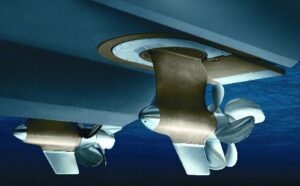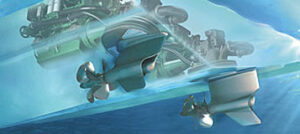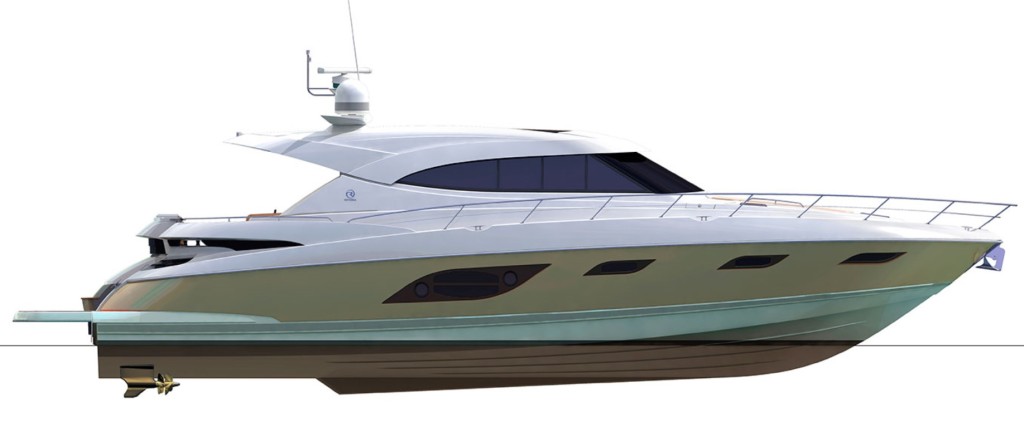This is a no BS assessment of my experience with Pod Drive powered yachts, from my personal experience as well as talking with numerous captains and owners.

Mercruiser Zeus Pod Drive

Volvo Penta IPS Pod Drive
Since hitting the scene for the first time in 2006, Pod Drives have been a huge subject of discussion throughout the industry…are they truly the next evolution in propulsion technology that will knock out the ages old shaft drives?
Let’s take a look at the pods themselves without all the fancy computerized technology. They are basically based off the old sterndrive technology that came around in the 1960’s and is still around today…a system that reduces drag and has a more direct line of thrust than traditional shaft drives, resulting in better fuel economy and speed. Pods took that basic design and improved upon it…making a more sturdy drive that can handle more horsepower, built heavier and of corrosion resistant materials so that it can withstand full time submerged in salt water, and a position underneath the boat instead of off the transom to enhance the level of control while at slow speeds. Additionally, like sterndrives, the exhaust is let out underwater, reducing noise and fumes.
All of the pods have 2 counter-rotating propellers per pod, which are necessary to provide the amount of thrust needed for the higher horsepower applications within the limited amount of space you have for propeller size. Also, with the smaller 4-blade propellers spinning faster than the larger, traditional props, you have less vibration. Sounds pretty good so far right? Enhanced fuel economy and performance with less noise and vibration. That covers the mechanical systems advantages of the pod drives.
With the addition of advanced computer technology, there are 2 great benefits built into the pod drive systems. Joystick Docking and Position Fixing. The joystick docking system enables a yacht owner to control the pods at low speeds with a joystick…with the boat moving in the direction which the joystick is pointed. This is accomplished by the computer receiving the direction signal from the joystick and telling the pods which way to turn and direct thrust to make it happen…this works with 2 or more pods working together and the results are pretty cool…you can literally move the boat sideways while counteracting current and wind.
The position fixing is also a great tool that makes boating much easier and more hassle free. When you press the position fix button on your control panel the pods will literally hold the current GPS position you are at by independently actuating the pods. This system has gotten more accurate as of late and some people will even trust it to hold the position of the boat in your slip while they tie on the dock lines…personally I would not feel comfortable doing that in case someone falls in the water…remember to hold the boat in place those props are still spinning!! I would use it in instances where you are somewhere waiting for other boats to join up with and want to hold your position, or if you are waiting for a bridge to open.
In summary the benefits are:
- Better fuel economy
- Increased handling and performance
- Less Noise
- Less Vibration
- Joystick Docking
- Position Fixing
These benefits certainly do add up and are all great! In the past few years though, there has been new technology come out that has given traditional shaft drive boats some of these benefits as well. While the mechanical aspects of the pods will provide better fuel economy and performance, many boats today with shaft drives offer underwater exhaust or muffler systems also to reduce noise and smoke, sound deadening material and air induction systems to reduce vibration, joystick docking systems are available that utilize the main engines and bow/stern thrusters, as well as systems that will position fix a boat also using the main engines and bow/stern thrusters very similar to the pods.
So even with all that technology you can add onto a shaft drive boat, the benefits of the pod drives remain that they have better fuel economy and increased handling and performance…with certain size limitations.
The fact of the matter is that some sizes and types of boats are better matched with pods than others.
I believe that the best boats for pod drives are express style cruising yachts in the 32-75ft size range. The express style has a lower center of gravity and smaller wind profile, which greatly helps the pods in docking and position holding applications. When pods are applied to a larger flybridge boat, the higher center of gravity and the thrust of the pods being concentrated in the back they tend to really rock and not be as responsive when trying to move sideways…you really need a bow thruster to help the pods also.
The reason I say cruising yacht is that the pods are best when just cruising around, maybe doing some sharp turns or banks for fun, and docking. If you are someone who really enjoys big game fishing where you will be doing all sorts of hard back-down maneuvers when chasing marlin, you may run into some issues with pods. They perform best for lighter duty applications, but are going to be more prone to faults or failures when subjected to the heavy stress of backing down on a fish going 10 knots. Remember that a shaft drive is very simple and sturdy…essentially just a rod coming out the bottom of the boat with a propeller attached…a pod drive has many smaller moving parts and high tech software. Additionally, they are not going to be as responsive as the larger propeller shaft drive boats…the low end torque will be less with the smaller pod propellers.
I have talked to a few captains and buyers who are fisherman and really like the position fixing feature of the pods…allowing them to hover over a spot and bottom fish without having to set the anchor. This seems like a solid concept except for the fact that to hold the position the props will have to be constantly moving with your engines on…which may serve to scare away fish or unduly cut the line. I think it may work in some places where the water and current are relatively calm where the pods do not have to work that much…it depends on the type of fishing you do.
The other caveat with pods is yacht weight. Due to the lesser low end torque of the smaller props, yachts that are heavier tend to suffer in performance with pods vs. shaft drives. This is the other issue that flybridges have with pods over and above the docking problem. Some lighter flybridge manufacturers like Meridian or Marquis may not have this problem because they use lighter hulls and materials throughout, but a bluewater offshore yacht like the Hatteras 60 with its solid fiberglass bottom needs the power and torque that the bigger props and engines of the shaft drives have.
So you are looking at a 6000 Riviera Express with twin Volvo IPS drives…it is the right type of yacht for pods. Are there any other issues or drawbacks I should be aware of?

For all of the great benefits of the pod drives, especially when mated to the right type of yacht, there are a few things that you need to be aware of going into it that are different from owning a boat with shaft drives.
- They are more expensive to maintain. As there are more moving parts and especially when they are on a boat that will be kept in the water full time, I would recommend hauling your yacht out of the water twice a year to check the pods for any issues or signs of water intrusion. Once a year you should have the pod drives fully serviced. taking these steps will greatly reduce your risk of having major problems or pod failures.
- They need to be serviced by certified technicians. This is not a big deal if you are primarily boating in areas where you know authorized service techs are…even if you are taking a trip or 2 to the Bahamas just know that if there is a major issue you may have to fly a tech and parts in to address the problem…it is like a new BMW nowadays…to diagnose the issues you need the right computer software and tools.
- Make sure that you are running the most advanced version of the pod software in your boat. From time to time a software update will come out for the pod drive computer system, making them more reliable…just make sure when you get the boat serviced that the latest software is being installed.
**Although the maintenance and service may be more on a pod boat, if you use it enough the fuel savings will more than make up for it!
As newer and more advanced pod drive technology comes out in the coming years these parameters in which pods work best may change…they certainly have carved out their space in the marine industry and have proven that they are here to stay!
For more information visit my other article: Pod Drives in Yachts; Volvo Penta IPS, Cummins Mercruiser Zeus and ZF Marine
Please feel free to contact me, Jimmy Rogers, if you would like to discuss pod drives and if they are right for you. I am a CPYB yacht broker and have made it my life’s work and passion finding the right yacht for my client’s boating needs. E-mail me at Jimmy@tgyg.com.

